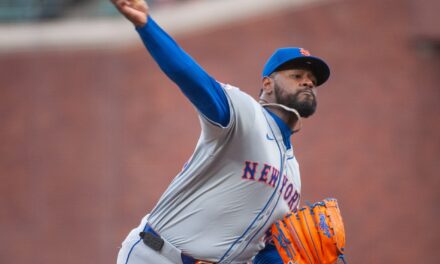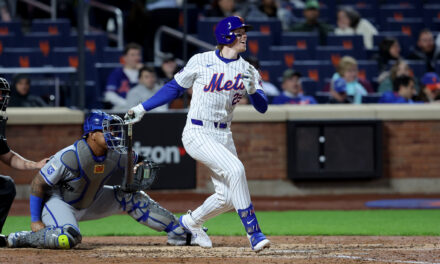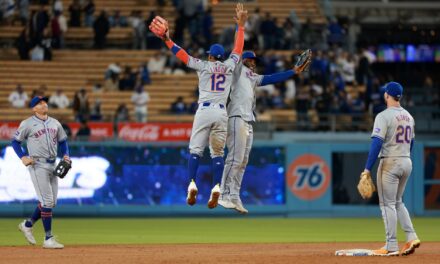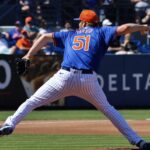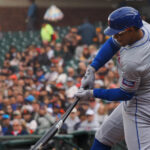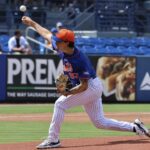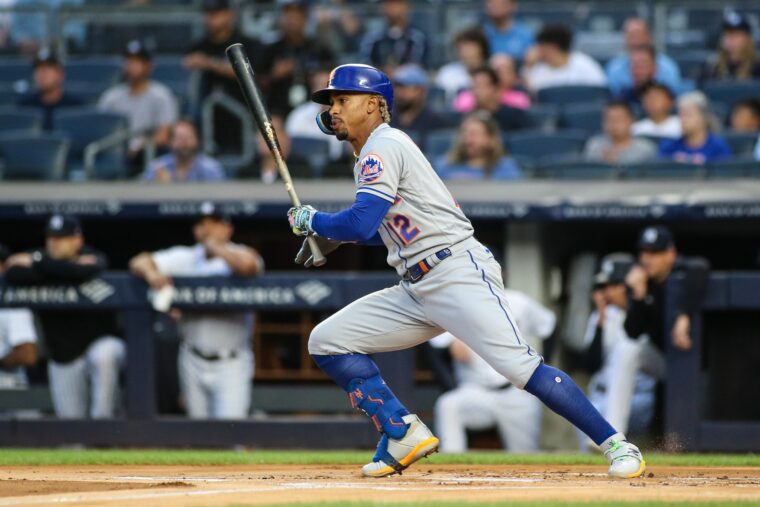
Wendell Cruz-USA TODAY Sports
When a team wins 101 games, the assumption is that many things went right.
However, when that same team is eliminated in the Wild Card Round of the playoffs with barely a whimper, it’s fair to look back and ask what went wrong.
The 2022 Mets were one of the most puzzling enigmas of the last number of seasons. There have been other good teams eliminated in the first round; as recently as three seasons ago, it was possible for a 106-win team to face a win-or-go-home elimination game. Indeed, the Atlanta Braves were eliminated after their first playoff series, as were the 111-win Los Angeles Dodgers.
However, just the way the Mets stumbled to 101 victories in the regular season foretold their possible demise. Unlike Atlanta and L.A., whose losses can be pinned more on the flukiness of the playoffs and bad matchups, the Mets headed into the postseason in a free-fall.
Lest we pin this entirely on momentum, it seemed for much of the season that the Mets’ biggest problem was their offense. Though many of their statistics were strong, the Amazins’ seemed incapable of getting the big hit at the right time. Although their starting pitching failed them near the very end of the season, even then it was their offense that assured defeat. Throughout the year, even when the bullpen blew games, it was the lack of scoring that ultimately doomed them.
So many Mets fans will point to the team’s record and seeming statistical strength as proof that running back virtually the same lineup will produce similar winning results. It’s easy to believe that, as the team seemingly still has a strong rotation and a significantly improved bullpen (that may still be further upgraded). However, there are a number of underlying metrics that paint a less sanguine picture of the Mets’ offense heading into 2023.
It Starts With Power
Since the analytical approach broke out of the realm of the Moneyball Oakland A’s and found its way around baseball, there has been a major emphasis on hitting the long ball. Hitters are taught to take uppercut swings and emphasize launch angle and exit velocity over avoiding strikeouts.
The 2022 Mets seemed to take the opposite approach, valuing contact over power. They struck out the third-fewest times of any team in baseball. It’s hard to say that this strategy didn’t work; after all, the Mets were fifth in the Majors in runs scored, fourth in hits, second in batting average and OBP, eighth in slugging percentage, sixth in OPS, fourth in OPS+, third in wRC+, and tied for fifth in wOBA. Running it back with the improvement of Omar Narváez over James McCann, however slight the difference is, should produce a similar result. Right?
Perhaps that’s true. Maybe the 2023 Mets will continue to score well on the way to another 100-win season. However, there were a few batting stats in which last year’s unit was not so strong, and most of them were power-related. The Mets were tied for 15th in home runs, 18th in barrel rate, 21st in hard-hit rate, tied for 15th in isolated power (ISO), and 18th in exit velocity and launch angle.
On the surface, if the Mets didn’t have a problem scoring runs, this does not seem to be an issue. However, one of the primary reasons that there is an emphasis on power is that once a ball is put in play without leaving the yard, it is largely left to factors outside the batter’s control. This is particularly true if the ball is hit on the ground, no matter how hard it is hit.
Spencer Strider and Zack Wheeler both showed their sour grapes by making comments about the Mets’ batting average on balls in play (BABIP). The Mets were tied for the sixth-highest BABIP in baseball despite below-average hard-hit and barrel rates. This would indicate that they were getting a certain amount of luck in where the balls went, particularly since their fly-ball rate was 22nd in baseball while their groundball rate was 13th. Because the Mets’ medium-hit rate was sixth in the Majors while their hard-hit rate was far lower, it seems that there was an element of good fortune in the Mets’ overall hitting success.
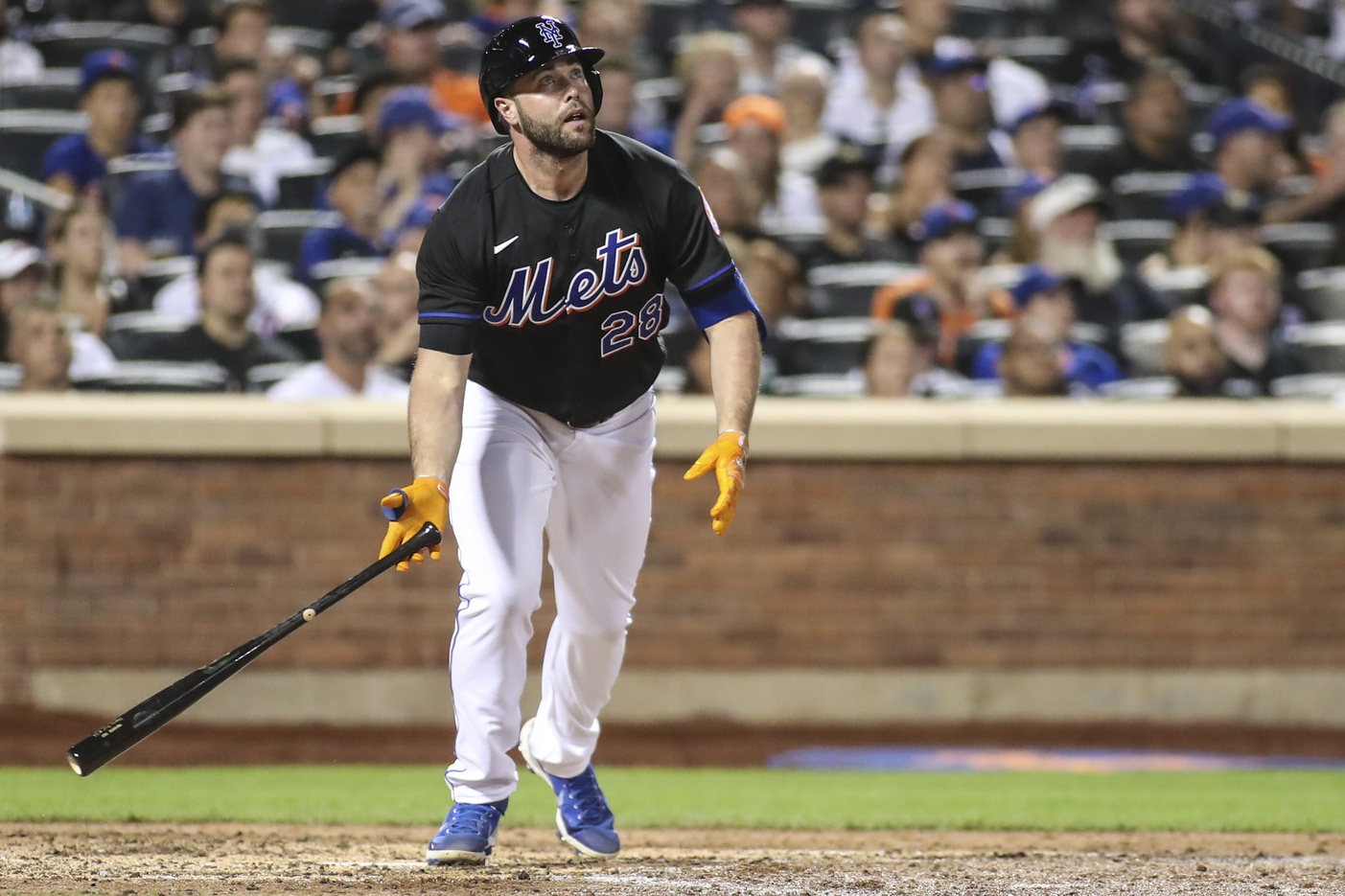
Wendell Cruz-USA TODAY Sports
Handedness Splits
The Mets ranked third in baseball with a .756 OPS against righties, trailing only the Dodgers and Blue Jays. However, that number plummeted to .716 against lefties, which ranked 14th. Although .716 is not terrible, the 40-point drop-off represented a sharp difficulty for the Mets when coupled with their overall inability to hit home runs consistently. Darin Ruf, the main player brought in to alleviate that difficulty in the second half of the season, hit .197 with a .413 OPS in 66 at-bats with the team, eventually finding himself on the IL to figure it out. Mark Vientos, who took his place, hit .167 with 12 strikeouts in 36 at-bats.
Overall, the Mets’ 32-23 record against left-handed starters ranked 10th in baseball, while their 69-38 record against righties ranked second. While a tenth-place record is not bad, it is still something to be wary of in a playoff series against a team with strong left-handed starters (although the Mets did beat lefty Blake Snell in their lone playoff victory of 2022).
Extra Bases Not Taken
When a team is focused on contact and lives base-to-base, they’d better maximize their chances by taking the extra base. Unfortunately, that was not the case for the 2022 Mets, whether due to a lack of general foot speed, poor baserunning, poor coaching, or a combination thereof.
Per FanGraphs, the Mets tied for 22nd in baseball with a 38% extra base taken rate. In overall baserunning (BsR), they ranked 26th with 10.7 runs below average. This did not help matters when trying to score runs.
Plate Discipline and Coverage
Per Statcast, the Mets ranked 17th in chase rate in 2022 at 29.5%. However, their contact rate on those pitches ranked second at 61%. Generally, these numbers are not predictive, meaning that there is a lot of fluctuation from season to season. If a team is making a lot of contact on chased pitches, there is no way to ensure that this rate will continue.
Furthermore, Statcast tracks the rate of meatballs faced by an offense, meaning pitches that are right down the middle of the plate. The Mets were tied for 21st in meatball rate at 7.1%. What does not bode so well for their offense, though, is that they swung at meatballs 76.2% of the time, tied for 20th.
Limiting the Shift
We can do a more thorough player-by-player breakdown of how the shift limitations will affect the Mets in 2023. However, as a team, the Mets were tied for sixth with a 25.7% opposite-field rate in 2022. The shift is weighted heavily against pull hitters, and the Mets ranked 25th in pull rate at 36%. Limitations on the shift are not likely to cause a sudden upswing in hitting for the Mets.

Jay Biggerstaff-USA TODAY Sports
The Loss of Correa
How would Carlos Correa have helped? Well, for one thing, he is just another hitter with pop. Although his home run total of 22 last year is not slugger-level, exactly, it would have been the third-highest on the Mets in 2022. He barreled the ball on 11.4% of his batted balls, well above the Mets’ team average of 7.1% and in the 81st percentile among hitters. His 44.7% hard-hit rate was in the 74th percentile.
However, there are a few other curious stats that actually might have made Correa a less-than-ideal fit for the Mets’ lineup. For one thing, Correa’s average launch angle was 11.6, below the MLB average of 12.1 and below the Mets’ team average of 11.9. His career 45.7% groundball rate is slightly worse than the average of 44.9%.
This is not to say that Correa would not have helped the Mets. They would sign up for an .833 OPS, 22 homers, and a lot of hard contact any day of the week if the contract number was right. However, Correa is not the true slugger that the Mets’ lineup seemingly lacks the most.
What Might Change in 2023?
If the Mets won 101 games in 2022 and ranked so highly in many offensive categories, why should that change in 2023?
Injuries: Brandon Nimmo, Starling Marte
Well, for one thing, several Mets players have age and injury concerns. Brandon Nimmo had 673 plate appearances, only the second time in his career that he topped 500. Although Nimmo is 29-years-old and should likely still have a few years off .800+ OPS left in the tank, his injury history is a concern offensively. Starling Marte is more of a regression risk heading into his age-34 season, and his injuries last season may have done the Mets in down the stretch. He has played in 120 and 118 games over the last two seasons, respectively, and it is fair to assume that he can end up somewhere in that range again.
Regression: Mark Canha, Francisco Lindor
With Mark Canha, the risk is not so much injuries as pure regression. He is also heading into his age-34 season and has seen his launch angle, barrel rate, xSLG, and xwOBA decline steadily over the last few years, suggesting that a downward shift is coming.
Furthermore, Francisco Lindor had his best season in three years, which always makes projection systems wary of a regression. The question is simply whether you believe that the 2022 Lindor was a return to his former self or an outlier in what was otherwise a slow downward trend.
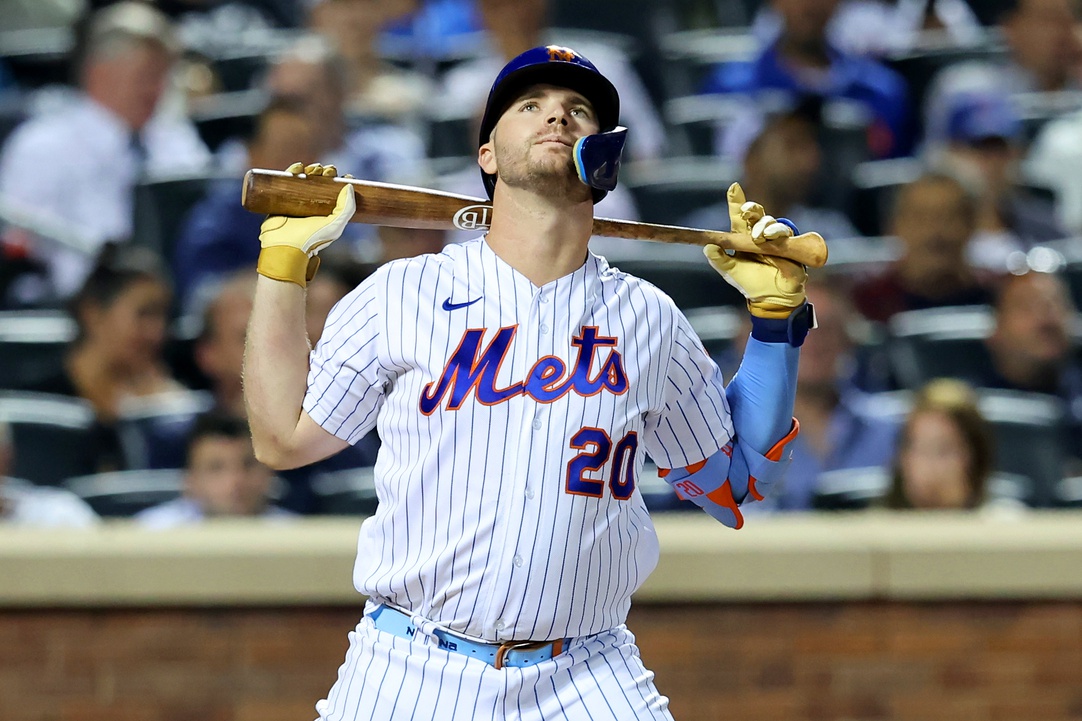
Brad Penner-USA TODAY Sports
Likely Consistent: Jeff McNeil, Pete Alonso
Of all the Mets’ players, the projection systems believe the least in Jeff McNeil’s 2022 season, likely due to his monumental rise in fWAR and his subpar 2021 season. It’s likely that McNeil will not be able replicate his outstanding 2022 marks, but considering that those numbers were not all that far off from his 2018-20 marks, betting on him is probably safe.
Pete Alonso is the Mets’ iron man: you know he’ll be good for at least 150 games a year, he’s going to give you close to 40 homers, and he’ll have a wRC+ at or above 130.
Wild Cards: 3B, DH, Catcher
The biggest wild cards for the Mets are the third base, DH, and catcher positions. With Correa no longer in the mix, it’s unknown whether the Mets will roll with Eduardo Escobar as the starting third baseman or platoon him with either Luis Guillorme or Brett Baty. Escobar himself is heading into his age-34 season after coming off a mostly-disappointing campaign that was offset by a ‘Month of Escobar’ September performance.
Although the Mets were expecting more from Escobar, his final numbers were not so wildly different than his previous season’s totals. It is more likely than not that if he is the Mets’ starting 3B, he will hit around 15-20 homers, bat .230 or so, strike out around 20% of the time, and put up an OPS of around .720-.730. That production may not be enough for the Mets to sustain offensive success.
The Mets love Guillorme’s glove and were pleasantly surprised by his offensive success early in 2022. However, after posting a .738 OPS in 224 at-bats prior to the All-Star break, Guillorme declined to a .598 OPS in 111 at-bats afterward. Guillorme does have a career .729 OPS vs. righties, which is respectable enough, but not when you consider that his SLG is just .359. That is just not good enough to be starting on most days.
The most intriguing option for the Mets is a platoon between Escobar and Baty. Baty is still the Mets’ No. 2 prospect and showcased hard contact skills in a short 11-game cameo prior to breaking his thumb. Although he did not light up the stat sheet, Baty’s .179 BABIP despite a 91.1 average exit velocity was seen as a sign of positive things to come. Furthermore, Baty does most of his damage against righties, and it showed up in his brief Majors stint, as both of his homers came off right-handers.
The bigger question for Baty is regarding his defense at third. He is raw with the glove, and the team’s pursuit of Correa showed that they do not necessarily see Baty as the third baseman of the future. However, Escobar himself is a below-average third baseman (he put up -3.0 Adjusted Defense last season, per FanGraphs), so the Mets may decide to bite the bullet and embrace a lefty-righty platoon. It remains to be seen if Baty can show enough as a hitter to balance out his defense and stick in the Majors.
At DH, the Mets clearly like Daniel Vogelbach for the left-handed part of the platoon. Vogelbach is the classic analytics-era hitter: he walks (15.8%) and strikes out (24.7%) a lot while maintaining a high OPS (.793). However, it’s important to realize that 2022 was Vogelbach’s best season with the bat, as his 128 wRC+ was 26 points higher than the prior season and the highest of his career by 16 points. Furthermore, he had played over 100 games only once prior (2019), which was, not coincidentally, his best year before 2022. The question is if he can at least maintain his offensive level last season, if not exceed it. There is a lot more pressure to do so as the presumed number five or six hitter in the lineup behind Lindor and Alonso.
On the left-handed side of the platoon, there are many rumors that the Mets are looking for an upgrade over Ruf. They acquired him from San Francisco for a large, if underwhelming prospect haul because of his career splits against lefties. Prior to joining the Mets, Ruf had put up an .887 OPS against lefties last year and had a .915 career OPS against them. However, he finished the season with a .753 OPS against lefties after a .152/.216/.197 statline down the stretch in New York.
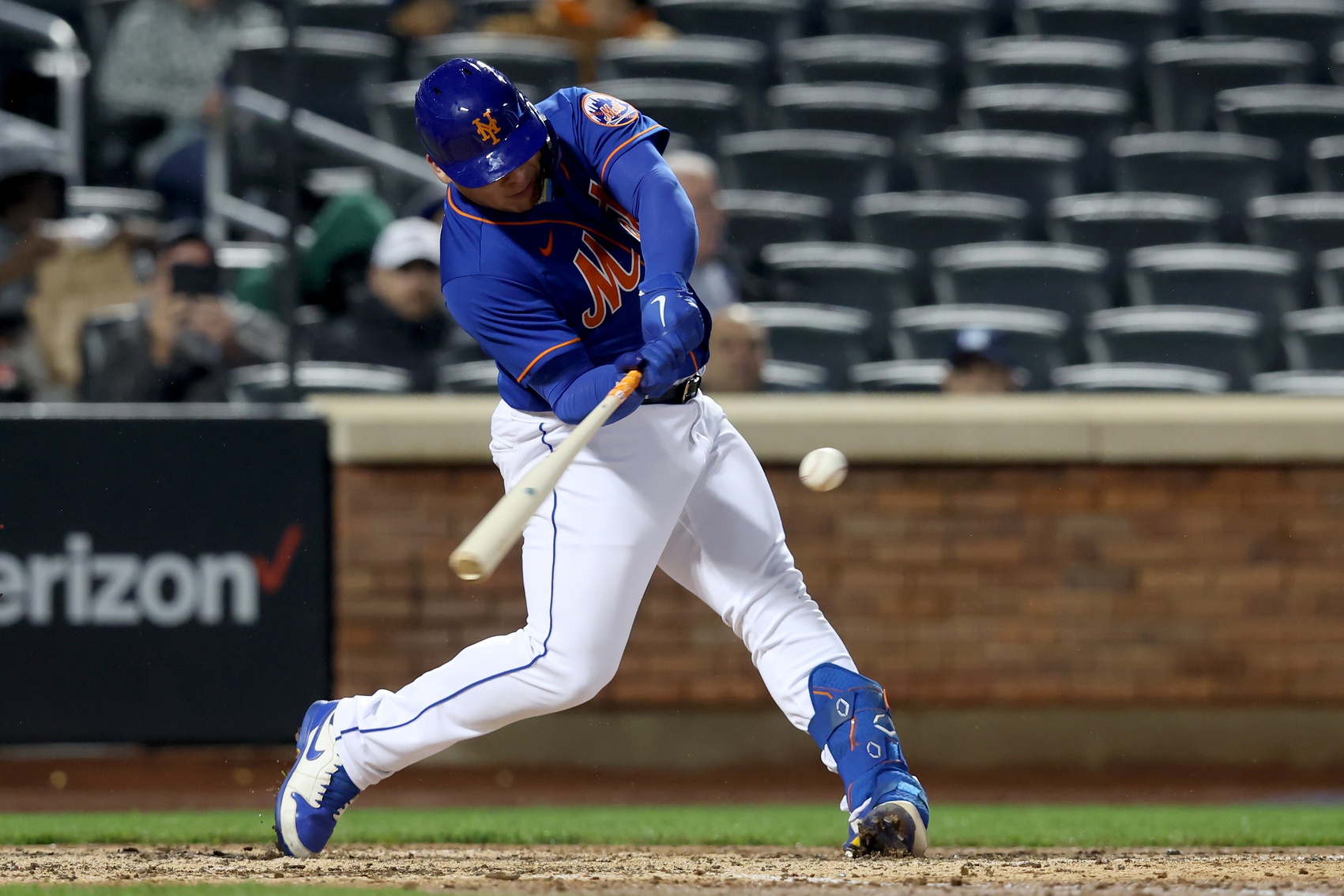
Brad Penner-USA TODAY Sports
Vientos is one option to replace Ruf, but it doesn’t seem overly likely that the Mets will go with him. For one thing, the team values Ruf’s defensive versatility, which Vientos does not provide. Additionally, the Vientos audition in 2022 did not go particularly well, as he hit .167/.268/.278/.546 in 41 plate appearances last September.
There are a number of Mets fans clamoring for Francisco Alvarez to take the right-handed platoon slot in 2023. However, that is highly unlikely to happen for several reasons. The Mets want to groom Alvarez as the catcher of the future, and that will not happen if he is in the Majors as a DH. Additionally, coming off ankle surgery, Alvarez is more likely to get the time he needs to readjust in Triple-A. Bringing him up at the end of the season was mostly a desperation move by the Mets and not one they are likely to repeat to begin 2023.
Given the above and notwithstanding Alvarez’s recent comments, the Mets will most likely begin 2023 with Narváez and Tomas Nido as their catchers. Whether this is a starter/backup situation or a platoon is unclear and will likely depend on Narváez’s early performance. Nido is better as a backup catcher, as his hitting (.600 OPS in 2022) is just not consistent enough to deserve more meaningful at-bats.
However, Narváez is coming off a down year, as he hit .206/.292/.305/.597 in 224 at-bats in 2022. That line is not all that different from Nido’s stats. The Mets are hoping that Narváez can hit more along the lines of his .258/.343/.386/.728 career stat line, which would make him their clear starter at catcher. It’s always risky to expect meaningful contributions from a player coming off a down year, though.
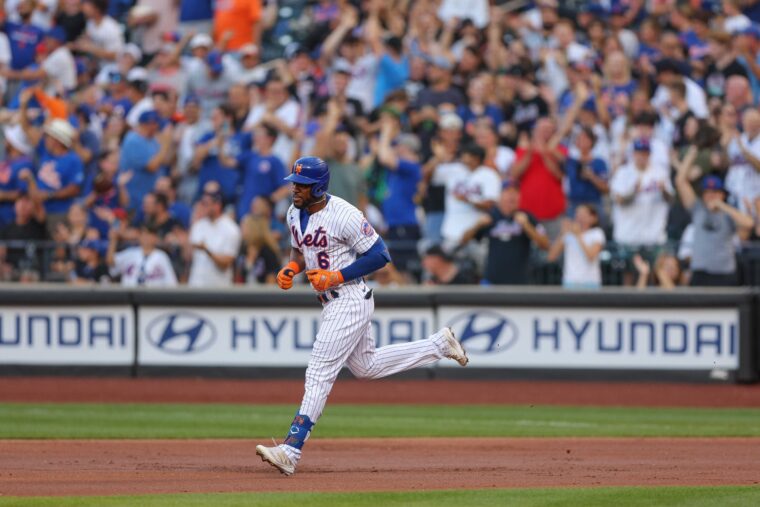
Vincent Carchietta-USA TODAY Sports
Bottom Line
Hitting is only one part of the equation for a baseball team. The 2022 Mets certainly hit enough to win 101 games and get into the dance. The falling apart of their starting pitching at the end of the season and their season-long struggles in getting the ball to Edwin Diaz could be pointed at as the primary culprits for the Mets’ early playoff demise.
Additionally, when a team wins 101 games and gets into the postseason dance, it’s likely they did many things right that could translate to a ring. Short series are fickle, and upsets are common. (Who would have predicted that the scuffling Phillies would be the NL representatives in the World Series?) If the Mets hit as they did in 2022, they will likely still be a very good offense.
That being said, for the reasons listed above—highlighted predominantly by the lack of power—there is an equally good chance that the Mets find themselves faltering down the stretch due to the inability to change the game with one big swing. Alonso and Lindor cannot do it all on their own. Alonso, in particular, was clearly pressing down the stretch last season, knowing that if he didn’t hit the big bomb, it was likely that no one else would.
The Mets’ options to correct that are relatively limited right now and come down to the hope that at least one of their young guys can reach their power potential as a rookie (if they’re even in the majors). The possibilities of a deadline trade are also suspect when you consider how teams price gouged on Steve Cohen at the 2022 deadline.
Will the Mets be a good team in 2023? Likely. Are they a contender? Yes. Will they win their division? The Braves are a formidable foe, and the defending NL champion Phillies are a force to be reckoned with, as well. It’s not going to be an easy road to accomplishing the first step that the Mets failed in last season.
Viewing the Mets’ lineup is a lot about carrying multiple truths simultaneously. The Mets have a good lineup but not an elite one. They can score runs but not at the level of teams like the Braves and Dodgers. They are relying on more things breaking the right way than Atlanta is.
Mets fans, the dialectic must live on.



